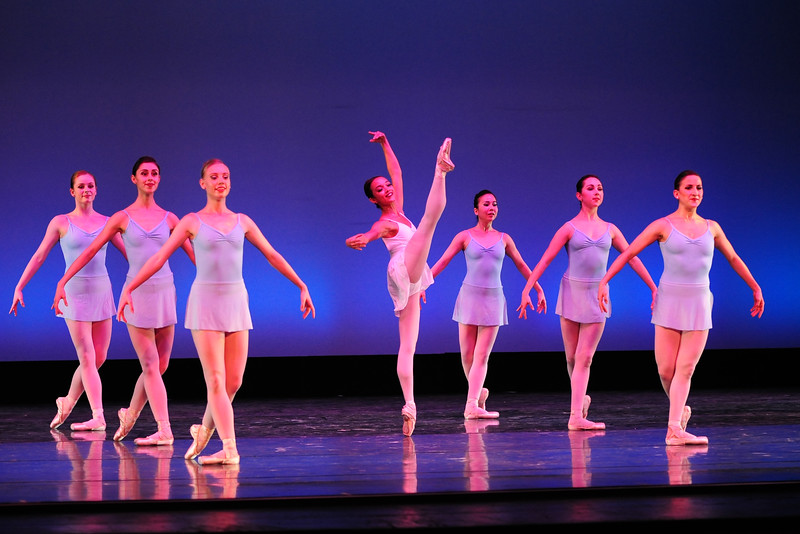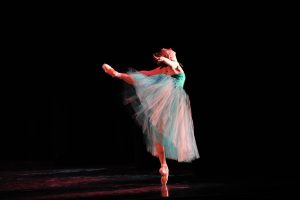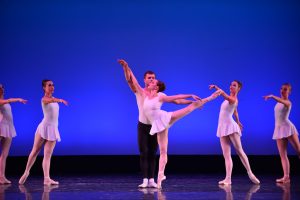Joyful ‘Square Dance’ Tops Extraordinary ‘Balanchine Masterworks’
The symmetry of “Concerto Barocco,” the gowns of “Emeralds,” and the joyful footwork in “Square Dance” highlighted Balanchine Masterworks, City Ballet of San Diego’s extraordinary program at the Spreckels Theatre last weekend.
The City Ballet Orchestra, with John Nettles conducting, has come a long way and sounded excellent, which made this performance a double delight for the eyes and ears.

“Square Dance” with Erica Alvarado and Corps. From Balanchine Masterworks, presented by City Ballet of San Diego. The George Balanchine Trust. Image Mario Scipione
City Ballet, co-directed by Steven and Elizabeth Wistrich, is honored to have 19 Balanchine works in its repertory. An extra-large audience Friday turned out for three plotless ballets by George Balanchine, including the San Diego premiere of “Square Dance,” his 1957 homage to American square dance forms.
Set to Vivaldi and Corelli, one expected baroque and court dances. Instead, hints of do si do grew to expansive landscapes. It started with a subtle bow and spiraled. Seven couples balanced and spiraled into floor patterns reminiscent of rolling wagon wheels.
Balanchine was a Russian émigré who loved all things American. He liked to wear cowboy shirts with pearl snaps and bolo string ties. For this ballet, he distilled square dancing. He squeezed folksy heel drags into his neoclassical style. Originally he had a caller on stage. After 1976, he replaced the caller with a male solo, a smart move.
It’s all about petite allegro and fast footwork. The playful dance made us want to shout yee-haw, but in a dignified way. Costumes were simple in shades of blue, gray, and white to evoke clouds against a sky blue background. The leads, Erica Alvarado and Stephano Candreva, stood out in icy white and cut through the corps with clean, grounded technique, but interacted with the group, like neighbors. A simple hand in hand gesture became significant. Candreva’s solo took on a mysterious, lonely quality and showcased his high level of dancing and musicality.
We didn’t want him to stop, yet the finale raised the joy factor even higher. Circling dancers leapt and kicked back an exaggerated high leg with infectious freedom, like a horse racing out of a corral.

Megan Jacobs balances in “Emeralds.” The George Balanchine Trust. Photo Mario Scipione
The performances of Balanchine ballets are presented in arrangement with The George Balanchine Trust. They are produced in accordance with the Balanchine Style and Balanchine Technique. Everything has to be authentic. The Trust sent Elyse Borne, an international répétiteur, to stage “Square Dance” and “Emeralds” (1967), from the three-act “Jewels.”
She attended Friday night’s program and visited back stage during intermissions. During rehearsals, Borne critiqued every angle and expression and shared insights gleaned from ballerina Violette Verdy who first danced “Emeralds.” Verdy died in Feb. of this year, and her interpretations were important here.
On Friday, Ariana Gonzalez revived Verdy’s articulate phrasing required for “Emeralds,” and her dramatic accents extended to the pas de deux with Candreva. When he lifted her, she seemed to walk on air. Sections completely devoted to changing arm positions were heartfelt.
The corps in “Emeralds” captured the neo-romantic tone and texture of Fauré’s score.
Costumes were by the original design by Karinska and over the top sparkly. Women wore gorgeous gowns with eye-pleasing layers of green, black and white. The men were intensely noble in jeweled waistbands. In spins, decorative flaps at their waists whirled upward and out like helicopter blades. Their final pose on one knee drew applause.

Ariana Gonzalez and Adam Bloodgood in “Concerto Barocco.” The George Balanchine Trust. Photo: Anna Scipione
“Concerto Barocco” (1940) caused our skin to tingle in tantalizing ways. Set to Bach’s Concerto in D minor for Two Violins, Ms. Gonzalez and Ms. Alvarado embodied two violins (played by soloists Salma Bachar and Jonathan Smith). The dancers could be viewed as sisters or friends, and Balanchine left it open for interpretation.
Staged for City Ballet by Nilas Martins, the movement became crisp and fast and was the perfect opener for this program. While white practice clothes may have seemed odd when “Barocco” premiered in 1940, sleek white fabric looked super on this energized cast. Most unusual and rewarding were sequences with women hopping on pointe with knees slightly bent. Balanchine wanted it to be plotless, but there were stories going on with those hopping Vs.
City Ballet of San Diego with the City Ballet Orchestra presents “Romeo & Juliet” May 6-8, 2016. cityballet.org. 858.272.8663

Kris Eitland covers dance and theater for Sandiegostory.com and freelances for other publications, including the Union Tribune and Dance Teacher Magazine. She grew up performing many dance styles and continued intensive modern dance and choreography at the Univ. of Minnesota, Duluth, and San Diego State Univ. She also holds a journalism degree from SDSU. Her career includes stints in commercial and public radio news production.
Eitland has won numerous Excellence in Journalism awards for criticism and reporting from the San Diego Press Club. She has served on the Press Club board since 2011 and is a past president. She is a co-founder of Sandiegostory.com. She has a passion for the arts, throwing parties with dancing and singing, and cruising the Pacific in her family’s vintage trawler. She trains dogs, skis, and loves seasonal trips to her home state of Minnesota.
